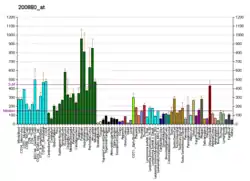DNAJA1
DnaJ homolog subfamily A member 1 is a protein that in humans is encoded by the DNAJA1 gene.[5][6][7]
References
- GRCh38: Ensembl release 89: ENSG00000086061 - Ensembl, May 2017
- GRCm38: Ensembl release 89: ENSMUSG00000028410 - Ensembl, May 2017
- "Human PubMed Reference:". National Center for Biotechnology Information, U.S. National Library of Medicine.
- "Mouse PubMed Reference:". National Center for Biotechnology Information, U.S. National Library of Medicine.
- Chellaiah A, Davis A, Mohanakumar T (August 1993). "Cloning of a unique human homologue of the Escherichia coli DNAJ heat shock protein". Biochim Biophys Acta. 1174 (1): 111–3. doi:10.1016/0167-4781(93)90103-k. PMID 8334160.
- Ohtsuka K, Hata M (January 2001). "Mammalian HSP40/DNAJ homologs: cloning of novel cDNAs and a proposal for their classification and nomenclature". Cell Stress Chaperones. 5 (2): 98–112. doi:10.1379/1466-1268(2000)005<0098:MHDHCO>2.0.CO;2. PMC 312896. PMID 11147971.
- "Entrez Gene: DNAJA1 DnaJ (Hsp40) homolog, subfamily A, member 1".
- Pei, L (January 1999). "Pituitary tumor-transforming gene protein associates with ribosomal protein S10 and a novel human homologue of DnaJ in testicular cells". J. Biol. Chem. UNITED STATES. 274 (5): 3151–8. doi:10.1074/jbc.274.5.3151. ISSN 0021-9258. PMID 9915854.
Further reading
- Oh S, Iwahori A, Kato S (1993). "Human cDNA encoding DnaJ protein homologue". Biochim. Biophys. Acta. 1174 (1): 114–6. doi:10.1016/0167-4781(93)90104-l. PMID 8334161.
- Kanazawa M, Terada K, Kato S, Mori M (1997). "HSDJ, a human homolog of DnaJ, is farnesylated and is involved in protein import into mitochondria". J. Biochem. 121 (5): 890–5. doi:10.1093/oxfordjournals.jbchem.a021670. PMID 9192730.
- Davis AR, Alevy YG, Chellaiah A, et al. (1998). "Characterization of HDJ-2, a human 40 kD heat shock protein". Int. J. Biochem. Cell Biol. 30 (11): 1203–21. doi:10.1016/S1357-2725(98)00091-0. PMID 9839446.
- Pei L (1999). "Pituitary tumor-transforming gene protein associates with ribosomal protein S10 and a novel human homologue of DnaJ in testicular cells". J. Biol. Chem. 274 (5): 3151–8. doi:10.1074/jbc.274.5.3151. PMID 9915854.
- Meacham GC, Lu Z, King S, et al. (1999). "The Hdj-2/Hsc70 chaperone pair facilitates early steps in CFTR biogenesis". EMBO J. 18 (6): 1492–505. doi:10.1093/emboj/18.6.1492. PMC 1171238. PMID 10075921.
- Terada K, Mori M (2000). "Human DnaJ homologs dj2 and dj3, and bag-1 are positive cochaperones of hsc70". J. Biol. Chem. 275 (32): 24728–34. doi:10.1074/jbc.M002021200. PMID 10816573.
- Jana NR, Tanaka M, Wang G, Nukina N (2000). "Polyglutamine length-dependent interaction of Hsp40 and Hsp70 family chaperones with truncated N-terminal huntingtin: their role in suppression of aggregation and cellular toxicity". Hum. Mol. Genet. 9 (13): 2009–18. doi:10.1093/hmg/9.13.2009. PMID 10942430.
- Bao YP, Cook LJ, O'Donovan D, et al. (2002). "Mammalian, yeast, bacterial, and chemical chaperones reduce aggregate formation and death in a cell model of oculopharyngeal muscular dystrophy". J. Biol. Chem. 277 (14): 12263–9. doi:10.1074/jbc.M109633200. PMID 11796717.
- Hernández MP, Chadli A, Toft DO (2002). "HSP40 binding is the first step in the HSP90 chaperoning pathway for the progesterone receptor". J. Biol. Chem. 277 (14): 11873–81. doi:10.1074/jbc.M111445200. PMID 11809754.
- Imai Y, Soda M, Hatakeyama S, et al. (2002). "CHIP is associated with Parkin, a gene responsible for familial Parkinson's disease, and enhances its ubiquitin ligase activity". Mol. Cell. 10 (1): 55–67. doi:10.1016/S1097-2765(02)00583-X. PMID 12150907.
- Strausberg RL, Feingold EA, Grouse LH, et al. (2003). "Generation and initial analysis of more than 15,000 full-length human and mouse cDNA sequences". Proc. Natl. Acad. Sci. U.S.A. 99 (26): 16899–903. Bibcode:2002PNAS...9916899M. doi:10.1073/pnas.242603899. PMC 139241. PMID 12477932.
- Hanai R, Mashima K (2004). "Characterization of two isoforms of a human DnaJ homologue, HSJ2". Mol. Biol. Rep. 30 (3): 149–53. doi:10.1023/A:1024916223616. PMID 12974469. S2CID 24105834.
- Lehner B, Semple JI, Brown SE, et al. (2004). "Analysis of a high-throughput yeast two-hybrid system and its use to predict the function of intracellular proteins encoded within the human MHC class III region". Genomics. 83 (1): 153–67. doi:10.1016/S0888-7543(03)00235-0. PMID 14667819.
- Bouwmeester T, Bauch A, Ruffner H, et al. (2004). "A physical and functional map of the human TNF-alpha/NF-kappa B signal transduction pathway". Nat. Cell Biol. 6 (2): 97–105. doi:10.1038/ncb1086. PMID 14743216. S2CID 11683986.
- Marschang P, Brich J, Weeber EJ, et al. (2004). "Normal development and fertility of knockout mice lacking the tumor suppressor gene LRP1b suggest functional compensation by LRP1". Mol. Cell. Biol. 24 (9): 3782–93. doi:10.1128/MCB.24.9.3782-3793.2004. PMC 387731. PMID 15082773.
- Gerhard DS, Wagner L, Feingold EA, et al. (2004). "The status, quality, and expansion of the NIH full-length cDNA project: the Mammalian Gene Collection (MGC)". Genome Res. 14 (10B): 2121–7. doi:10.1101/gr.2596504. PMC 528928. PMID 15489334.
- Rush J, Moritz A, Lee KA, et al. (2005). "Immunoaffinity profiling of tyrosine phosphorylation in cancer cells". Nat. Biotechnol. 23 (1): 94–101. doi:10.1038/nbt1046. PMID 15592455. S2CID 7200157.
- Hu Y, Zhou Z, Huang X, et al. (2005). "Expression of a novel DnaJA1 alternative splicing in human testis and sperm". Int. J. Androl. 27 (6): 343–9. doi:10.1111/j.1365-2605.2004.00492.x. PMID 15595953.
This article is issued from Wikipedia. The text is licensed under Creative Commons - Attribution - Sharealike. Additional terms may apply for the media files.





